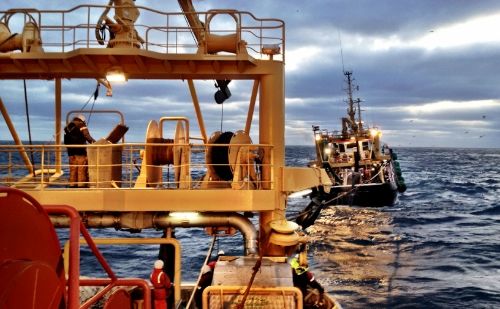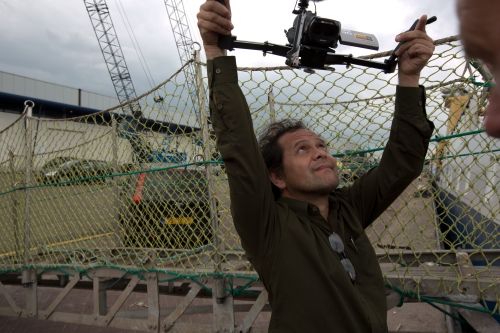This year’s Tribeca Film Festival hosted a spectacular collection of documentaries, as diverse in technique and guiding philosophy as they were in subject matter. Floating calmly in the mix was siblings Leonard and Hetty Naaijkens Retel Helmrich’s RAW HERRING (reviewed by Steve here), a modest production with some unassumingly brilliant cinematography, which also packs a complex philosophy behind its deceptively simple subject: Herring fishermen plying their trade off the coast of Holland.
While i snuck some time off from my studies to take in some of the festival, school was apparently still in session. Any notions of kicking back were dashed as I realized Leonard, the half of the directing duo who would be my interview subject, directed a trilogy including Sundance award winner Position Among The Stars and no less than invented the filming style known as SIngle Shot Cinema.
On a Sunday morning we met at the Tribeca press lounge, but opting for a quieter environment, took a characteristically New York City stroll over to his office at NYU, where he is teaching a class on filmmaking. There Helmrich spoke enthusiastically and at length on what influenced him to make the film and the numerous decisions that go into presenting a documentary in order to convey a particular point of view.
Retel Helmrich’s insight left me encouraged to be liberal with editing and shifting around parts of our conversation rather than presenting it as one straight take. So it is arranged in three segments, each dealing with a different theme. Below is talk of what got the film started and the technical aspects of shooting it. Parts 2 and 3 will get into the trickiness of capturing a documentary subject naturally and the cultural aspects of Dutch herring fishing, respectively.

On what influenced you to make the film
I was interested in the subject because I like herring. Well, I was asked to do this. Somebody asked me and said hey, would you like to do a film about herring. And one of the reasons why I took it was, not only that my ancestors went from there by boat to Indonesia...This is all true. But my main reason is that Grierson - he was a documentary filmmaker from the early 20s - and he made the film, I think in 1929, called Drifters. And Grierson is actually the person who invented or gave us the name documentary because he was the first one who mentioned documentary, and often everybody sees him as the godfather of documentary.
Drifters was also about herring fishers in the North Sea, which is the same area where my fishers were fishing. The funny things is in the film, the fisherman who the captain of my ship is talking to is a drifter. He’s a Scottish fisherman, Alex. And they are sharing information about where the herring is. Grierson also made his film about the changing environment and the changing technology to fish. It’s funny, it’s the same area, the same kind of fisherman are in both films, and also focusing on the people who are fishing. For me it was a bit of an honor to be able to make a follow up of Drifters actually because I see Raw Herring as a followup to Drifters.
There are a lot of films about fishermen. I think it’s one of the professions being most documented. It was a challenge to do it in a way that was different than any other person has done. The only film that inspired me to make it is Drifters. That’s why I felt OK i want to do it. I watched it and looked at how he did it, and thought about how I could do it.
On the trips out to sea
The first 2 (trips) were each 8 - 10 days. And the last one was 14 days. During the first trip, I was quite often seasick. That made me aware that i have to do something about it. They have pills you can take, and also somebody said they have plaster that you could put behind your ear. It gives the kind of stuff that makes you not seasick, because seasickness has to do with your balance system and it makes balance system less sensitive.
The problem is it really makes you a bit stoned. I wasn’t really aware of that, but when I was looking at my footage,I thought this is horrible. a lot of this stuff i couldn’t use. So I had to make a third trip. So the last time i went out, I didn’t use the plaster. and even though sometimes the sea was very rough that time, I wasn’t seasick at all. Maybe even the plaster helped me to get used to it. I don’t know.
I had a lot of better footage during my third trip than the 2nd trip. The footage from the 2nd trip I couldn’t use much. It’s a trick sometimes, you have to make some changes. During the first trip i shot the whole thing of the captain searching for the fish.
On working with an assistant
It was only during the 2nd trip. It was me and an assistant. But the assistant was mostly on his own. Because i couldn’t have somebody else on the boat in the shot. Especially my way of filming is you have to be able to cover the scene as a whole. when somebody else is in it, who is not me and also not somebody in the crew, it also belongs to the whole. In that case I have to outframe that person all the time. and that’s a lot of work. I have to be aware of it. The only thing is they really wanted me to have a sound operator but that was really a nuisance. It was not his fault but the fact that he was there was very intrusive, especially with a big boom and everything. You can’t have someone else there who is influencing the dynamics of the group. That’s why I said i’d make another trip but not with a sound operator. And finally I couldn’t use anything of the sound operator because he really had to hide so much that he could never put the microphone closer to the subject than i could physically with my camera, because I also had a good microphone on the camera. So I know I will never work with a sound operator again, because shooting single-shot? cinema, it doesn’t fit in that way.
On filming the herring capture
Of course I read about how they did it. The first I saw it I thought, ‘how can I shoot this in a way that has never been done before, a way that is not too obvious?’ I didn’t want to shoot it in a way, like for instance ‘Deadliest Catch.’ It was all kinds of standard ways of using the camera and covering so many things. It was only when I was there and I was looking down at them as little puppets moving around. It was for me kind of like a little ballet what they were doing. So I thought I want to shoot it like that.
When I’m there physically walking around I could be in the way and it’s also dangerous to be there on the deck. You could be hooked into by one of the nets. Before you know it, you’re in the current. It’s dangerous. Accidents like that happen quite often still. I didn’t want to take the risk and I still wanted to shoot it as a kind of God’s eye view and even bird’s eye view. That’s why I got this long stick. it’s 9 meters long. The one I was also using underwater for catching the birds diving under the water for fish. And I used this long stick to go on this big scaffold on the back of the boat and going around and orbiting around the people.

I used a very long extendable stick. the kind you’d usually use for sweeping windows on the second floor from the ground level. But I had a very little camera on it so I could orbit around the people. Especially the orbit because I’m teaching single shot cinema, which means trying to cover scenes in one shot. It doesn’t mean you also show the scenes in 1 shot. You try to shoot it all in 1 shot. That means that every second of that shot, you should be able to use, so you shoot from all different angles that are available. But in a way that you still can edit it and condense it into a shorter timespan.
And that’s what I do with the long stick, I could not see what I was looking at. But by using an orbit, because an orbit is a kind of camera movement never being mentioned in film language as being something that can be used to narrate your story. But actually the orbit is something that I introduced with single shot cinema. It’s a camera movement that always keeps the interest in the frame and you keep it pointing at the subject all the time until your next shot enters the frame organically. Panning is not done for me. It’s always orbiting.
On filming the herring net in one take
It was fine. So I could get all the shots I needed from that one big catch. And I had to because every catch, there is normally different weather. So it’s difficult to intercut shots from other catches. Of course I also did that in a number of other catches, but I only used one catch. And I knew that when I had it the way I wanted it, I knew that the next catch I want to cover it also in a different way. So that’s why I did the complete opposite. I put a fixed camera with the roll of the net in the foreground and then you had this fast timelapse. In fast speed you see it and fading over the nexts being rolled in. And that’s how you can have another approach to the same kind of scene.
On filming the on-ship processing of the fish after the capture
It’s a factory. it’s not craftsmanship anymore. it’s just a big floating factory, actually. So that’s what I wanted to show. How the whole thing is being almost digested by the boat, you could say. Being processed and becoming this package of frozen fish. That’s what I wanted to show.
Stay tuned for Part 2...soon!
Stay tuned for Part 2...soon!
No comments:
Post a Comment